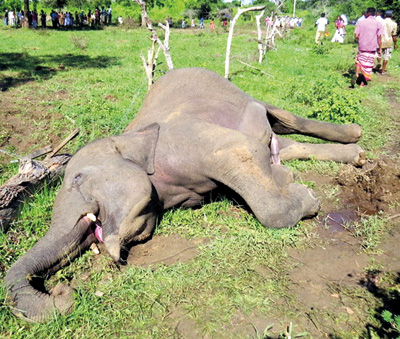News
Wildlife Minister gives ear to concerns of activists and promises action
No more guns will be issued to personnel of the Civil Defence Force (CDF) for use against elephants, while also recalling the guns already issued to some of them, Wildlife Resources Minister S.M. Chandrasena has assured.

An elephant shot dead. File pic
Minister Chandrasena gave these assurances at a meeting with environmental activists on Wednesday, sources told the Sunday Times, pointing out that he had also promised to review the human-elephant conflict (HEC) mitigation strategy.
These activists including Ven. Pahiyangala Ananda Sagara Thera – who along with many others had earlier picketed against the decision to issue guns to CDF personnel – commended the Minister for giving ear to their concerns and the evidence-based rational thinking from experts such as Dr. Prithiviraj Fernando of the Centre for Conservation & Research.
A major catalyst in this group, the Wildlife & Nature Protection Society (WNPS), has been actively pointing out the problems with regard to the issuance of such guns, while also participating in protests and making written objections.
The discussions with the Minister also focused on the volatile and deteriorating situation of the HEC and the haphazard manner in which these issues are being dealt with, it is learnt.
The Sunday Times last week spotlighted the dangers of issuing such guns in a report headlined ‘Howls of protests but DWC allays fears’.
The Cabinet of Ministers on December 10, last year (2019) approved a paper put up by the ministry to issue 546 guns to CDF personnel who would be involved in maintaining the electric fences installed to prevent the HEC, said ministry Secretary Jayanthi Wijethunga when contacted by the Sunday Times, pointing out that Minister Chandrasena assured environmentalists that he would take their concerns back to Cabinet and seek its approval to stop the issue of guns.
This is while he would also request Cabinet to give its anumethiya (permission) for the guns already issued to be kept in the armoury of the Department of Wildlife Conservation (DWC), she said.
When asked what type of guns has been issued to CDF personnel, she said that they were shot guns and repeaters and 500 had been distributed in the Anuradhapura and Ampara districts.
Among some of the other measures that the ministry is hoping to implement is the extension of the electric fences which currently cover about 4,440 kms; getting more CDF personnel to help in the maintenance (nadaththu karanna) of the electric fences; and providing more facilities such as motorcycles and tractor-trailers and also setting up more mura-kuti (guard points) with facilities for them.
“We also hope to establish committees at different levels to bring about a solution to the HEC as we need the villagers’ support,” said Mrs. Wijethunga, naming them as Gam Niyamana Kamitu (in the village), Pradeshiya Niyamana Kamitu (at Divisional Secretary level) and District Niyamana Kamitu (at District Secretary level). This is while policy decisions would be taken by the national level committee headed by Minister Chandrasena.
The ministry is also hoping to schedule another paper for Cabinet approval to increase the compensation paid to the family of a person who has been killed due to the HEC as well as for crop and property destruction.
Meanwhile, the Sunday Times understands that at Wednesday’s meeting, Minister Chandrasena had also instructed that there should be more DWC ranger presence in the HEC-affected areas mainly the north-central region.
He had directed that a committee be appointed under the Director-General of the DWC and comprising the relevant officials (including the Forest Department and the Central Environmental Authority) and experts to brief him on a more scientific approach on how the rising death toll of both elephants and people and the negative impact of the HEC could be contained better.
“This is a very important step for all stakeholders and this new stance from the Minister and the government is acknowledged, provided these measures are executed speedily and effectively,” said the WNPS, adding that it aims to keep up the intense pressure on all such policy actions while extending its support to all conservation initiatives which balance the development interest of the nation, the welfare of the people and the wellbeing and survival of the country’s precious fauna and flora.
On a suggestion of the activists, Minister Chandrasena had made a decision to evaluate the current placement of electric fences to see whether they could be moved to ecological boundaries rather than being on administrative boundaries, where they are now, it is learnt.
“Over 60% of the 4,500 kms of electric fences are in forests and located between DWC and Forest Department areas. There are elephants on both sides of these fences and in most such cases there are no fences preventing elephants from entering villages and cultivations from these forests,” a source pointed out.
The Minister had directed ministry Secretary Wijethunga to get senior officials of both departments (DWC and Forest) to work together and have a consistent management plan for all areas.
“If implemented, this decision would be a major step in mitigating the HEC in the future. For years, the WNPS and others have requested that the Forest Department and DWC come under the same ministry as at present and this is an example of its benefit,” the source added.

